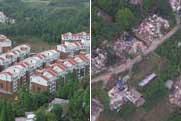China
"Tibet issue" is by no means a religious issue
Source: People's Daily | 04-29-2008 17:52
Special Report: 3.14 Tibet RiotsThe Dalai clique has been drumming for the international concerns over the so-called "Tibet issue", and manipulated the foreign opinion by playing the card of religion and claiming "Tibetans are in shortage of religious freedom."In actuality, however, it is a ruse clad in the disguise of religion, as Thiru N.Ram, the editor-in-chief of the Indian newspaper The Hindu, was quoted as saying, "the accusations of China by the Dalai clique are contradicting the facts".
As a matter of fact, Tibet's religious development conforms to its social development and reality. It is estimated that Tibet currently boasts 1,700 monasteries and temples, with 46,000 monks and nuns; in addition, it has 4 Mosques and 1 Catholic Church. The normal religious activities of the Tibetan people are always fully respected and guaranteed. The establishment of the institute is a pioneering undertaking in the history of Tibetan Buddhism. Tibetan Buddhism is a profound theology, the understanding of which requires many years of dedicated study. The Higher Institute of Tibetan Buddhism represents an innovation in the educational system in Tibet, and by offering degrees and attracting the most gifted students, it will further promote the unique spiritual legacy and meaning of Tibetan Buddhism.
On top of that, prayer wheels and reverential believers can be seen everywhere in Tibetan-inhabited areas. The Tibetan Buddhism has become an important ideological prop for people there. Each year, there are millions of Tibetans trekking to Lhasa for pilgrimage.
The state respects and safeguards the rights of the Tibetans and other ethnic groups in Tibet to live their lives and conduct social activities in accordance with their traditional customs, and their freedoms to engage in normal religious activities and major religious and folk festival celebrations.
There are many traditional festivals and fairs in Tibet, including the Tibetan New Year, Sakadawa Festival, Ongkor (Bumper Harvest) Festival, Shoton (Yogurt) Festival, just to name a few. In the past two decades, the state has invested up to 700 min yuan in the repair and maintenance of monasteries and temples, religion-related cultural relics and historical sites. The Potala Palace, the Norbulingka and Sakya Monastery have been well preserved. Ancient documents and archives have also been rescued and are well protected today.
The religious beliefs of Tibetan religious followers can enjoy full respect and protection, and the fine aspects of traditional Tibetan culture have been carefully preserved and carried forward. Compared with the old days in Tibet, when religious belief was compulsory, and Tibetan Buddhism was the only religion accessible to and permissible for the public, Tibet's religious culture today is no longer monopolized by Tibetan Buddhism, instead, other ancient Buddhist sects, such as the oldest religion Bon, also thrive with Tibetan Buddhism still being the dominant religion.
It is evident to show that the so-called "religious issue" in Tibet is nothing but a pretext made by the Dalai clique in an attempt to win over some sympathetic support. The true essence of the alleged "Tibet issue" is to seek Tibet's independence and secession from China.
Editor:Xiong Qu



